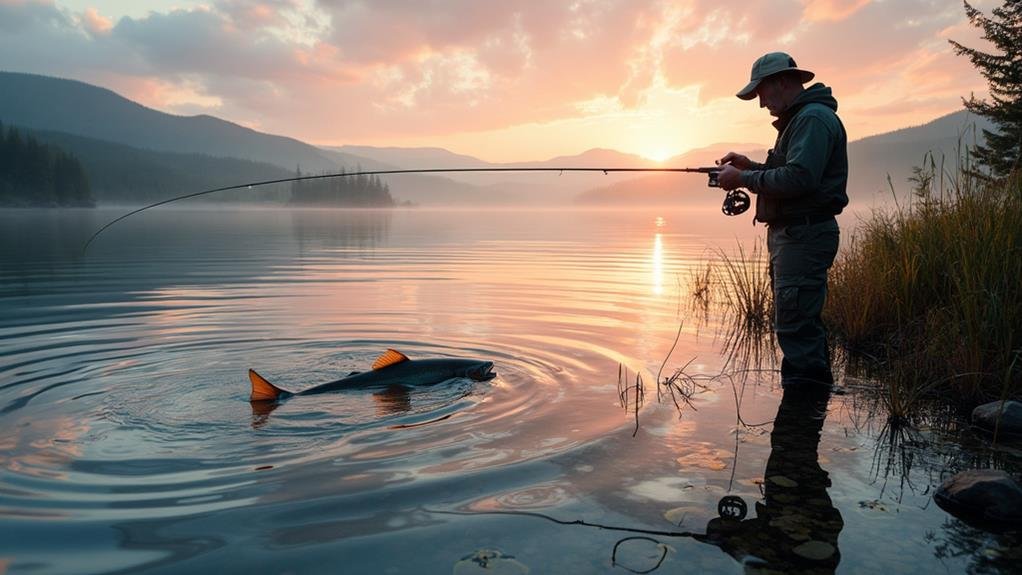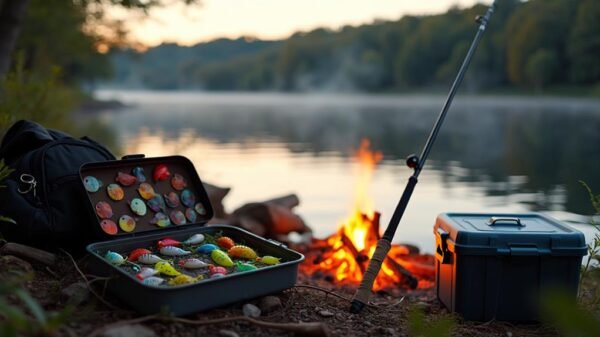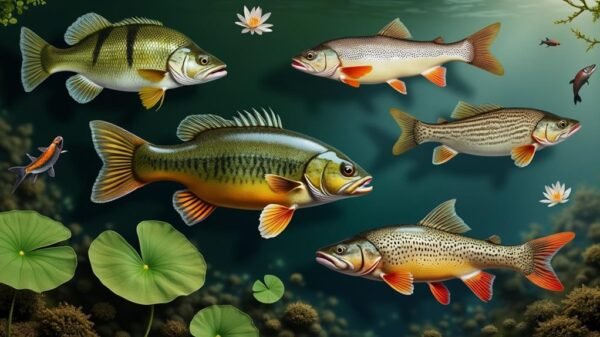To succeed in freshwater trout fishing, start by understanding their behavior. Target cool, clear waters near structures like boulders and fallen trees, especially during dawn and dusk. Use lightweight rods between 5 to 7 feet paired with a 4 to 8-pound line. In spring, focus on rivers where trout feed on insects, while summer calls for cooler, shaded areas. Adapt your strategy to water conditions—clear waters need smaller lures, while murky waters benefit from larger ones. Investigate effective bait options, like live worms and spinners, to increase your chances. Keep going to explore more expert tips for your next fishing adventure!
Understanding Trout Behavior
To successfully catch freshwater trout, it's essential to understand their habits in relation to their habitat. Trout are habitual animals, often located in specific spots that offer food, protection, and optimal water conditions. They thrive in cool, clear rivers and lakes, frequently found near structures such as boulders, fallen trees, or aquatic vegetation. This understanding allows anglers to select their fishing locations strategically. Additionally, seasonal variations can affect trout behavior, so being mindful of these shifts can enhance your fishing approach.
Timing is also crucial. Trout are most active during dawn and dusk, making these times ideal for fishing. They react to weather changes as well; on cloudy days, they may be more likely to leave their shelters, while sunny conditions often drive them deeper into the water.
Knowledge of trout's diet is vital. They primarily consume insects, small baitfish, and crustaceans. Using bait or lures that mimic their natural food sources increases your chances of a successful catch. By monitoring their behavior and adjusting your techniques accordingly, you can enjoy the freedom of fishing. Embrace the excitement of the pursuit, and let your expertise lead you to a fruitful fishing experience.
Selecting the Right Tackle

Understanding trout habits is crucial for choosing the appropriate tackle. When you embark on a fishing trip to catch these slippery beauties, having the right equipment significantly enhances your experience. Start with your fishing rod; a lightweight model between 5 to 7 feet is optimal for most freshwater trout. This length provides the sensitivity necessary to detect gentle nibbles. Pair it with a reel that complements your rod's strength and can withstand the struggle of a trout. Additionally, consider adding multi-jointed lures like the Rapala Jointed Minnow to your tackle, as they emulate the swimming action of prey, making them effective for luring trout.
Next, focus on your fishing line. A 4 to 8-pound test line is ideal for trout fishing. It's light enough to remain nearly invisible underwater, yet robust enough to land a substantial catch. And don't overlook hooks! Size 10 to 12 hooks are perfect for smaller bait, while larger hooks are suitable when using bigger lures.
Seasonal Fishing Strategies

Seasonal variations significantly influence trout angling success. Each season presents distinct opportunities and challenges, and grasping these can enhance your catch. Besides water temperature, elements such as diurnal patterns fish activity levels, which can greatly affect your fishing outcomes.
- Spring: As water temperatures rise, trout become increasingly active. Target rivers and streams where they feed on aquatic insects. Early mornings or late evenings are ideal for angling.
- Summer: During hot weather, trout often seek cooler environments. Investigate shaded areas or deeper pools. Early mornings or late afternoons are optimal, as trout show heightened activity when temperatures decline.
- Fall: As water temperatures drop, trout prepare for the winter months. They feed vigorously to accumulate energy reserves. This is the perfect time to utilize larger lures, simulating the plentiful food sources available.
Adapting to Water Conditions

Adapting your fishing methods to varying water conditions is crucial for success. In scenarios where the water is high and murky, like during rainstorms in Florida, trout often reside near the riverbed. Utilize heavier sinkers and larger lures, such as the Strike King Red Eye Shad, that create significant vibrations to capture their interest despite the limited visibility. Notably, popular freshwater locations like Lake Okeechobee can be significantly impacted by these changing water conditions, making timing essential.
Conversely, in clear waters, trout exhibit heightened caution. It's advisable to use smaller lures, such as the Rapala Original Floater, and lighter fishing lines to maintain a natural appearance. Stealth is paramount; approach the water quietly and avoid casting shadows. Additionally, water temperature influences trout behavior; during warmer months, they often seek cooler, deeper areas throughout the day. Focus your fishing efforts during dawn or dusk when they tend to be more active. Recognizing these subtle variations can elevate your fishing experience and increase your chances of landing that prized trout. Stay vigilant about the water's condition and adjust your techniques accordingly for a rewarding fishing adventure.
Effective Bait and Lures

Selecting the right bait and lures significantly impacts your trout fishing success. With numerous options available, it's crucial to choose what suits your fishing environment best. For example, realistic lures from TRUSCEND enhance your chances of catching trout due to their high imitation design. Here are three effective choices to consider:
- Live Worms: Classic bait for freshwater fishing, live worms attract trout with their natural movement, making them irresistible.
- Spinners: These lures create vibrations and flashes, mimicking injured fish. Utilize bright-colored spinners on sunny days to draw trout from afar.
- PowerBait: A popular artificial bait available in various colors and scents, PowerBait is perfect for catching stocked trout. Shape it around your hook, and you're ready to fish!
Experimenting with these options can elevate your fishing experience. Pay attention to water conditions and adapt your bait accordingly. Whether you cherish the thrill of the catch or the serenity of the outdoors, using the right bait and lures helps you connect with elusive trout. So gear up, venture out, and enjoy the freedom that fishing provides!























